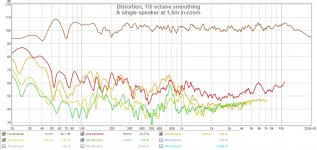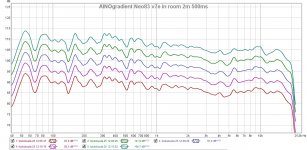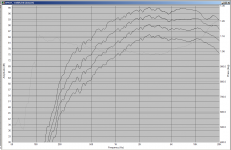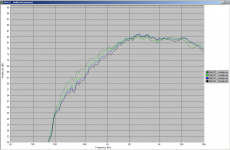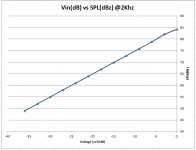I haven't dome measurements at very low spl, but searched for power compression. This is a 4-way speaker, but a single driver behaves basically alike. Our hearing has diffrent sensitivity per frequency, Fletcher-Munson curves.
Distortion is quite low at typical listening spl and we can read several tests about when it gets audible (frequency dependant). REW can show fundamental and distortion spl simultaneously. Some examples.
Distortion is quite low at typical listening spl and we can read several tests about when it gets audible (frequency dependant). REW can show fundamental and distortion spl simultaneously. Some examples.
Attachments
OK I found my DMS37 measurements. These were taken in room at 30cm distance, 16th octave smoothed.
From -25db to -10db (I think -25db was 2.8V) The sweep was high passed at 200Hz. The tweeter was being tortured therefore at the -10db level! I probably should do it again but with a HP at say 1Khz and see if that changes anything.
First is just the plots relative to each other. Note that the -25db I have had to fudge the absolute level, because it was taken with the mic preamp on high gain, and I had to go to lower gain for the other three.
Tony.
From -25db to -10db (I think -25db was 2.8V) The sweep was high passed at 200Hz. The tweeter was being tortured therefore at the -10db level! I probably should do it again but with a HP at say 1Khz and see if that changes anything.
First is just the plots relative to each other. Note that the -25db I have had to fudge the absolute level, because it was taken with the mic preamp on high gain, and I had to go to lower gain for the other three.
Tony.
Attachments
Might be true. But I haven't seen a single measurement to back up the claim. If it has been shown please point out where.It's been shown there is very little deviation from linearity. Are you still concerned with how small details are reproduced in the presence of larger signals?
I don't know what you are not seeing in the FR curves that have been shown? It's the fact that they track each other so uniformly that shows they change very little with level
There was this interesting thread, and there are 2 posts that have measurements that I did.
Frequency graphs of speakers....
Frequency graphs of speakers....
Something must have caused this general increase in distortion at -40 dB, but could anyone be sure it was the imperfection of the transducers?
I'm still thinking about the damping effect of speaker suspensions...
But assuming large cone area, in the region controlled only by inertia (far from Fs freguency), the motor should never "get stuck".
Isn't it?
At least if the velocity of the sound in the membrane material is significantly higher than in the air, the input must roughly always correspond to the output.
Because energy will not be converted into heat before the end of the cycle.
Yes, the curves look good and all. I have never questioned them. But the whole point with the thread was to point out that flat curves isn't everything. I am not asking whether the curves are flat or not. Or if they change shape with sound pressure. I am asking if the sound pressure increases linearily with input. All I have seen is that if you increase the sound pressure 15dB the sound pressure will increase 15dB. It says nothing. But I haven't seen actual measurement of how much input power that differs between the two.I don't know what you are not seeing in the FR curves that have been shown? It's the fact that they track each other so uniformly that shows they change very little with level
Will a 32-fold decrease in input power result in 15dB lower sound pressure? Or will it be 16 or 17dB lower? The fact that the curves track each other has nothing to do with how input scales with output. Friction and losses to heat are never linear unless you have a completely frictionless system. The question is how large they are, if they matter. Still haven't seen a single measurement.
Maybe there are numbers of input power somewhere that I've missed. But please show where if that is the case.
Last edited:
I see, then studying this will help answer your questions https://www.klippel.de/fileadmin/_m...linearities–Causes_Parameters_Symptoms_01.pdfFriction and losses to heat are never linear unless you have a completely frictionless system. The question is how large they are, if they matter. Still haven't seen a single measurement.
Maybe there are numbers of input power somewhere that I've missed. But please show where if that is the case.
well at least Klippel is acknowledging that there is response variation due to distortion and that the large signal behavior is different from what is traditionally measured for Theile/Small so forgive me if it's an erroneous conclusion that response varies with volume but it is more evidence that the traditional conclusion that loudspeakers are "linear" is somewhat of a falsehood.
so forgive me if it's an erroneous conclusion that response varies with volume but it is more evidence that the traditional conclusion that loudspeakers are "linear" is somewhat of a falsehood.
You are forgiven 😉 How did you come to that false conclusion? 🙂 It's all a matter of degrees, but as you see from the graphs posted and linked too, not a major issue with decent drivers, unless, of course you think the measurements everyone is using are erroneous?
for me it's more a question of how much the response varies and to what degree and thus far on some of the speakers i've tested it can be as much as 6 to 8 db at various frequencies and Q's.
and although it may be pedantic of me i can't stand loudspeakers being described as "linear" devices...
and although it may be pedantic of me i can't stand loudspeakers being described as "linear" devices...
I don't think anyone has, they've been called minimum phase, they're obviously non linear as evidenced by their relatively high harmonic distortion.
I used the phrase "deviation from linearity" as used here SoundStageNetwork.com | SoundStage.com - NRC Measurements: Elac Uni-Fi Slim FS U5 Loudspeakers It does seem an odd phrase, granted
I used the phrase "deviation from linearity" as used here SoundStageNetwork.com | SoundStage.com - NRC Measurements: Elac Uni-Fi Slim FS U5 Loudspeakers It does seem an odd phrase, granted
Last edited:
i could point to a few forums threads...but that would just serve to make me appear more pedantic.
Hehe, I know what you mean, rest assured a linear speaker would, I think, blow everyone away............
look at the heat and what it does to freq response
but i doubt that many of you listen at that high sound levels so this is an real issue
but i doubt that many of you listen at that high sound levels so this is an real issue
I’m also NOT a believer of flat, low THD, and low diffraction speakers.
I find BBC like dip (2-4k dip) is more forgiving than flat response, and slight 10K boost is a usually positive effect for adding air to the source. Also narrow range fullrange speaker is very convincing to my ears for older music sources.
Dr. Toole has been insisting flat frequency speaker (with 6dB tilt) and I followed him, but now I’m not sure if it’s really the goal for us, practically and pragmatically. You would say my speaker and room have issues, but who has a perfect speaker in the perfect room? (One of my room is extremely well treated with 10 meter long diffusers and tons of OC703, btw.)
I personally prefer having adequate 2nd harmonics at the lower end for everyday listening. Clean low end is boring, tiring, lack of forgiveness, and less musical to my ears. I agree with 15” woofer + SET guys in this regard. I honestly never liked the sound of small woofers in closed box. Not only the the sound of bass is far from real one with those tight small woofers, but also I find it’s much harder to tell the low frequency “pitch” (below 70Hz) mostly due to lack of required harmonics, and I know the sound of the real bass, both acoustic and electronic. Bass harmonics should be emphasized, while it is already done in the recording / mixing process.
I also was experimenting the difference between soft and hard membranes. More their frequency response is matched with digital EQ, clearer the difference is. It seems rigid membrane has more accurate linearity (better transient, better small signal detail, etc), but the resonance (of the recording, or of the membranes, it’s hard to separate them) is more audible and often disturbing. I would say both colored, and it's hard to choose between them.
I do not like the sound of round baffle speakers with less diffraction for some reasons. This is probably just because I grew up and worked with flat baffle studio monitors for a long time, but also I think I dislike the idea of making the speaker “disappear”. The speaker is there in this room, and it’s so unnatural for me pretending it’s not there. I feel sympathy with the speaker that insists on its existence in the room. I'm listening to the sound from the speaker, that is the reality.
Well, when I see the picture of the apple in the museum, I'm educated enough not comparing it with real apple. 🙂
I find BBC like dip (2-4k dip) is more forgiving than flat response, and slight 10K boost is a usually positive effect for adding air to the source. Also narrow range fullrange speaker is very convincing to my ears for older music sources.
Dr. Toole has been insisting flat frequency speaker (with 6dB tilt) and I followed him, but now I’m not sure if it’s really the goal for us, practically and pragmatically. You would say my speaker and room have issues, but who has a perfect speaker in the perfect room? (One of my room is extremely well treated with 10 meter long diffusers and tons of OC703, btw.)
I personally prefer having adequate 2nd harmonics at the lower end for everyday listening. Clean low end is boring, tiring, lack of forgiveness, and less musical to my ears. I agree with 15” woofer + SET guys in this regard. I honestly never liked the sound of small woofers in closed box. Not only the the sound of bass is far from real one with those tight small woofers, but also I find it’s much harder to tell the low frequency “pitch” (below 70Hz) mostly due to lack of required harmonics, and I know the sound of the real bass, both acoustic and electronic. Bass harmonics should be emphasized, while it is already done in the recording / mixing process.
I also was experimenting the difference between soft and hard membranes. More their frequency response is matched with digital EQ, clearer the difference is. It seems rigid membrane has more accurate linearity (better transient, better small signal detail, etc), but the resonance (of the recording, or of the membranes, it’s hard to separate them) is more audible and often disturbing. I would say both colored, and it's hard to choose between them.
I do not like the sound of round baffle speakers with less diffraction for some reasons. This is probably just because I grew up and worked with flat baffle studio monitors for a long time, but also I think I dislike the idea of making the speaker “disappear”. The speaker is there in this room, and it’s so unnatural for me pretending it’s not there. I feel sympathy with the speaker that insists on its existence in the room. I'm listening to the sound from the speaker, that is the reality.
Well, when I see the picture of the apple in the museum, I'm educated enough not comparing it with real apple. 🙂
Last edited:
Something must have caused this general increase in distortion at -40 dB, but could anyone be sure it was the imperfection of the transducers?
I'm still thinking about the damping effect of speaker suspensions...
But assuming large cone area, in the region controlled only by inertia (far from Fs freguency), the motor should never "get stuck".
Isn't it?
At least if the velocity of the sound in the membrane material is significantly higher than in the air, the input must roughly always correspond to the output.
Because energy will not be converted into heat before the end of the cycle.
Possibly, the friction components could be a proportionately larger factor as the drive levels are lowered. At some point the drive level will be too low to overcome friction, it seemed like it was trending to that point. The levels where the THD was increasing are very low.
Last edited:
There was this interesting thread, and there are 2 posts that have measurements that I did.
Frequency graphs of speakers....
Frequency graphs of speakers....
Another graph for the PC83 that was not done in a previous test. Since SPL (dB) is a logrithmic measure, the corresponding change in voltage must also be logrithmic (dB) to see the relationship. The relationship is linear and the slope is 1.
How did the levels scale with power input?
Any measurements of that? 🙂
See attached graph.
.
Attachments
Last edited:
This thread is about your misconception about drivers and speaker design. Your misconception is based on reading (and not comprehending) only one book on loudspeakers, on accepting Quora and speaker design notes (largely marketing technobabble) as your source of knowledge... and nothing else! Oh, do not forget your wrongly defined measurements. Measuring speaker frequency response with signal generator and SPL meter!? Please...hi Sonce, thanks for your kind advice...but this thread is nothing about speaker design as i mentioned before.
speaker driver design maybe better, but just marginally.
Please read Floyd Toole book and several others, you will thank me wholeheartedly much more, later.
I am asking if the sound pressure increases linearily with input. All I have seen is that if you increase the sound pressure 15dB the sound pressure will increase 15dB. It says nothing. But I haven't seen actual measurement of how much input power that differs between the two.
Maybe there are numbers of input power somewhere that I've missed. But please show where if that is the case.
Will a 32-fold decrease in input power result in 15dB lower sound pressure? Or will it be 16 or 17dB lower? The fact that the curves track each other has nothing to do with how input scales with output. Friction and losses to heat are never linear unless you have a completely frictionless system. The question is how large they are, if they matter. Still haven't seen a single measurement.
Should be able to calculate them. I mentioned in the post that -25db was 2.8V. That -25db is the INPUT volume level to the amp. as is the -20db and through to -10db The graph is what was picked up by the Mic with those input levels. SO if -25db is 2.8V (lets assume the tweeter is 8 ohms nominal) that is 1W
-10 db should be around 16V so that will be around 32W
On the last question, the first three curves are all relative, the last one as I said I fudged, because the mic preamp I had to switch to lower gain when I upped the levels. I reduced it 20db (which is the difference between the low and high gain settings of the mic preamp).
edit: the second graph I subtracted the difference from the -25db level measurement from each measurement and overlayed them to show the differences in response. so the -10db measurement had 15db subtracted.
Tony.
Quality can be subjective. Accuracy is not. Quality in my definition goes beyond reproduction (accuracy) and into perception.
Accuracy means reproduction of source - in amplitude, phase and with the same recorded distortion.
Quality takes accuracy and adds in room effects and listener location and preferences. The equal loudness curve is included here then we overlay that with personal preference.
Both accuracy and quality are affected by the recording. If the recording is peaky in a sensitive frequency range or full of distortion, then we perceive this as poor quality - even through an accurate pair of speakers.
My goal these days is to build a pair of speakers that makes everything sound good. My current speakers make some music sound fantastic to my ears, and others awful - needing EQ especially in the 2500Hz - 4000Hz region (especially centered around 3,500Hz). Most of this forwardness comes from the tweeter - even though it has less amplitude than the adjacent midrange.
The tweeter shows no HD distortion above the 1% or level (infact far under) under gated measurement conditions.
So for me - a BBC dip is more favourable - based on the music I listen to (80s). My speaker is not accurate under this definition, but I enjoy it over a wider range of material.
Accuracy means reproduction of source - in amplitude, phase and with the same recorded distortion.
Quality takes accuracy and adds in room effects and listener location and preferences. The equal loudness curve is included here then we overlay that with personal preference.
Both accuracy and quality are affected by the recording. If the recording is peaky in a sensitive frequency range or full of distortion, then we perceive this as poor quality - even through an accurate pair of speakers.
My goal these days is to build a pair of speakers that makes everything sound good. My current speakers make some music sound fantastic to my ears, and others awful - needing EQ especially in the 2500Hz - 4000Hz region (especially centered around 3,500Hz). Most of this forwardness comes from the tweeter - even though it has less amplitude than the adjacent midrange.
The tweeter shows no HD distortion above the 1% or level (infact far under) under gated measurement conditions.
So for me - a BBC dip is more favourable - based on the music I listen to (80s). My speaker is not accurate under this definition, but I enjoy it over a wider range of material.
- Status
- Not open for further replies.
- Home
- Loudspeakers
- Multi-Way
- speaker drivers: flat frequency response does NOT mean good sound quality
